Pioneering (scouting)
Pioneering is the art of using ropes and wooden spars joined by lashings and knots to create a structure. Pioneering can be used for constructing small items such as camp gadgets up to larger structures such as bridges and towers. These may be recreational, decorative, or functional.[1][2]
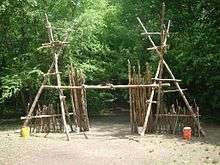
Pioneering is used to teach practical skills, teamwork and problem solving. It is widely used in Scouting and Girl Guiding. Many Scout and Guide groups train their members in pioneering skills and construct projects, both small and large. In camp, they may construct functional items like tables, camp dressers and gadgets, as well as decorative camp gateways. Pioneering is a common merit badge in many countries, and was required for the Eagle Scout rank in the 1920s and 1930s.
The name comes from the 18th and 19th century military engineers who went ahead of an army to "pioneer" a route, which could involve building bridges and towers with rope and timber (for example the Royal Pioneer Corps).
Pioneering skills include knot tying (tying ropes together), lashing (tying spars together with rope), whipping (binding the end of a rope with thin twine), splicing (joining or binding the end of a rope using its own fibres), and skills related to the use, care and storage of ropes, spars and related pioneering equipment.
Basic knots
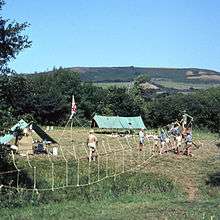
There are a number of basic knots used in pioneering:[3]
There are also a number of specialized pioneering knots that are used to add safety and functionality to pioneering projects:[4]
- Butterfly Loop
- Carrick Bend
- Rolling hitch
- Roundturn and Two Half Hitches
Basic lashings
- Square lashing, which gets its name from the fact the wraps are “square” to the poles. Square Lashings bind poles that are in contact and cross each other at any angle from 45° to 90°
- Diagonal lashing, used when securing two spars when they cross but do not touch as in the "X" of an H-frame trestle [5]
- Round lashing, used to join two poles in a straight line
- Sheer lashing, (also spelled Shear Lashing) used to join two poles in a scissors shape, to be spread out, most often to form the legs of an A-frame[6]
Pioneering structures
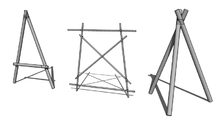
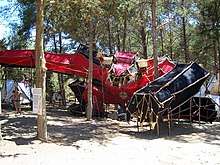
These basic structures are the building blocks for a number of pioneering projects:
- A-Frame: The basis of many tower structures. The horizontal member of the A-frame also makes a convenient springing point for a deck such as a table-top.
- Trestle: Used as a modular element for building bridges and towers. Also used as a 'chariot' for inter-Patrol chariot races. Often referred to as X-Trestle or H-Trestle
- Tripod: As end supports for swingbridges, dining tables, etc. and as the basis for the hourglass tower. A tripod is not considered secure unless its legs connected with cross braces, or are staked or otherwise attached to the ground.
Pioneering projects
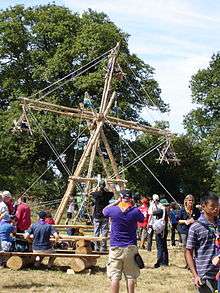
- Aerial runways
- Ballistae
- Benches
- Bridges
- Camp gadgets
- Camp gateways
- Catapults
- Chairs
- Chippewa Kitchens
- Dressers
- Ferris Wheel
- Flagpoles
- Merry-Go-Rounds
- Rafts
- See Saws
- Swing Sets
- Swinging Ships
- Tables
- Towers
- Trebuchets
- Tacky Taun-Taun
See also
References
- Design: 1234.info / Modified: Darren Dowling. "Scouting Resources". scoutingresources.org.uk.
- "Pioneering Project: Big and small" (PDF).
- "Knot Book" (PDF).
- "Older Merit Badge Pamphlet". SCOUT - PIONEERING.
- http://scoutpioneering.com/2014/12/14/traditional-diagonal-lashing/
- http://scoutpioneering.com/2013/10/14/the-somewhat-ambiguous-shear-lashing/
External links
| Wikimedia Commons has media related to Pioneering. |
- Scoutbase—UK Scout Association website, with lots of projects
- Ropes and Poles—Pioneering blog—growing collection of unusual projects
- scoutpioneering.com—photos, diagrams, illustrations and procedures
- PioneeringProjects.org—Large collection of pioneering projects and links to resources
- pioneeringmadeeasy—Large collection of pioneering projects for the scouts free of charge
- Scouting Resources—Pioneering projects and lashings